In this report, Syrians for Truth and Justice (STJ) reveals the details of the field execution of civilians Tamer A. and Jumaa H., who were shot in the head from behind and their bodies burned in the middle of the city of A’zaz in northern rural Aleppo, on 25 April 2024.
The two civilians were killed on suspicion of involvement in a bombing in A’zaz on 31 March 2024, which caused several deaths and injuries among civilians and extensive material damage. The suspects were killed during their transfer by the Military Police to a prison in the city until their prosecution.
Local authorities are promoting a narrative that masked gunmen attacked a Military Police patrol, seized the two suspects, and killed them – overstepping the role of the judicial institution. However, reliable information obtained by STJ for this report confirms the involvement of members of the Levant Front faction in the killing with the consent of their leaders.
The Levant Front/Al-Jabha Al-Shamiya faction, led by Azzam al-Gharib, better known as Abu al-Ezz Saraqib, controls the city of A’zaz in northern rural Aleppo, which is part of the Euphrates Shield area.[1] This area is under the military control of the Syrian National Army (SNA), which operates under the umbrella of the Syrian Interim Government (SIG) affiliated with Türkiye. The SIG is responsible for managing administrative, legal, and judicial matters, with overall direction from the Turkish coordinator.
The killing of the two suspects is part of a pattern of numerous violations in areas controlled by the SNA. These areas are marked by impunity due to the absence of the rule of law and ineffective judicial institutions of the SIG. Armed factions undermine these institutions by directly punishing individuals they consider “violators” without involving the judiciary. They also take on responsibilities that should be handled exclusively by the judiciary, such as conducting investigations and verifying evidence for fair trials and appropriate penalties. Additionally, direct interference by Türkiye in judicial processes and decisions further weaken these institutions, compromising their independence and integrity.
In recent similar incidents, the Eastern Army/Jaysh al-Sharqiya carried out a sentence of whipping publicly against a young man in al-Bab city, northern rural Aleppo, for allegedly “insulting god.” Furthermore, the Levant Front arrested 15 Syrians in A’zaz for protesting near a Turkish convoy. These individuals were not given access to judicial proceedings or fair trials under the directions of the Turkish coordinator.
The present report examines the killing of two suspects, highlighting the flawed accountability processes in northwest Syria. Instead of fair trials conducted by the judicial institution, the SNA armed factions are carrying out Qesas (retribution) sentence in the region.
The report is based on two interviews conducted by a field researcher at STJ with a military source from the SNA, and a local of A’zaz, who witnessed the field execution.
The interviews were conducted online using a secure communication application. Both sources were informed that the interviews were voluntary and were told how the information they provided would be used, including in this report. They have requested that their identities not be revealed due to the sensitive nature of the information. In addition to the interviews, the report draws from a large number of open-source materials that discuss the killing after verifying the information contained in them.
-
Bombing and Arrest of Suspects
At dawn on 31 March 2024, a car bomb rocked a popular market in the center of A’zaz near the four-way intersections of A’zaz’s covered market and al-Jisr Street and the street leading to the old al-Hal market.
The explosion resulted in the deaths of seven civilians, including two children and a pregnant woman, and caused injuries to thirty others, as reported by a source at the A’zaz National Hospital contacted by STJ. The Syria Civil Defence (White Helmets) documented extensive damage to shops and homes in the vicinity of the explosion.
Using open sources, STJ’s digital analysis expert determined the approximate location of the explosion, which STJ relied on to design these images.
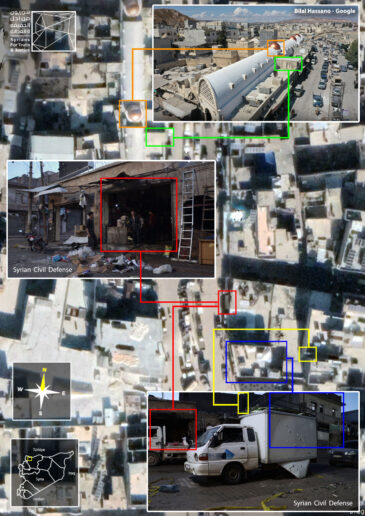
The first image: A collage of images from various sources which were compared with a satellite image (the background) to pinpoint the exact location of the explosion and an image showing its aftermath. Sources: Bilal Hassano – Syria Civil Defence. Image 1. Image 2.
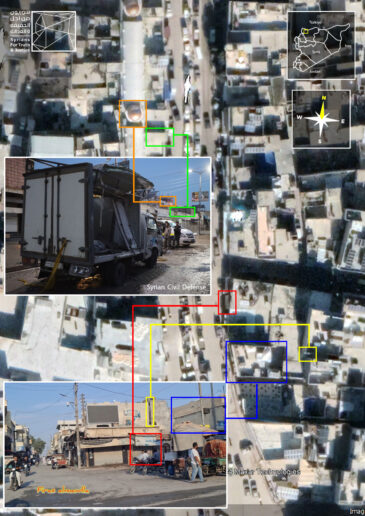
The second image: Images from various sources were compared with a satellite image (the background) to pinpoint the location of the explosion from another angle. Sources: image 1: Syria Civil Defence; image 2: Firas al-Mawla.
On 3 April 2024, Saleh Amouri, a leader in the SNA, announced that the security forces of the Northern Storm Brigade, a faction within the Levant Front, had successfully located and apprehended the individuals responsible for the car bombing after days of surveillance and mobilization. This announcement was made in a statement published on his personal Facebook page.
The day after the suspects were arrested, the Levant Front released a video in which two individuals confessed to carrying out the bombing. The two suspects work in shipping goods between the cities of A’zaz and Manbij, which are controlled by the Syrian Democratic Forces (SDF). One of them stated that a security officer in the Kurdistan Workers’ Party (PKK) in Manbij gave him a wheel with an explosive device inside and asked him to detonate it at the Teranda checkpoint in Afrin or any Military Police checkpoint.
The two defendants explained that they were unable to plant the bomb at the Teranda checkpoint because of the many surveillance cameras. Instead, they decided to go to A’zaz. There, they placed the bomb in a Suzuki car in the square behind the post office, followed the car until it reached the entrance to the market, and then detonated the bomb remotely.
The two defendants also said that the PKK security officer transferred them 700 USD to carry out the bombing, The Levant Front mentioned that it withheld some information for the purpose of the investigation.
Investigations by the Levant Front concluded that these two individuals were involved in carrying out the bombing based on two pieces of evidence. Mahmoud Fadl,[2] a high-ranking military source in the SNA, detailed this matter,
“The evidence against the individuals responsible for the bombing crime included their car being captured on street cameras driving in front of the car that was blown up. Additionally, one of the individuals had been investigated (earlier A’zaz explosion) for a potential explosive device in his car’s diesel tanker after transporting goods from Manbij to A’zaz. These individuals operated an office for shipping goods between areas of the SDF and the SNA. There is no other evidence besides these pieces of evidence and their confessions. The owner of the car and his friend were arrested after their car’s number was identified, as they worked together in the shipping office.”
On 25 April, after the Levant Front completed its investigations, it handed over the two suspects to a Military Police patrol to transfer them to prison for trial.
On the same day, news spread that the two suspects were killed and their bodies burned at the same site where the bombing occurred. This happened after armed and “masked” individuals blocked the Military Police patrol’s path, took the accused, and killed them in front of a gathering of civilians.
- The Levant Front Operates Behind a Veil
The Levant Front released a statement (see Appendix 1) condemning the attack on the police patrol, the kidnapping and killing of the accused before they were tried, and supporting “retribution against the killers in the liberated [areas]… provided that retribution is carried out within the official judicial system.”
The Front focused on its role in the bombing case, stating that its tasks were limited to investigations, gathering necessary information, and making arrangements with the Military Police to “hand over the accused for trial per the law.”
However, information obtained by STJ from Mahmoud Fadl, a military source in the SNA, confirms that the decision to execute the two suspects was made at a leader-level within the Levant Front.
Mahmoud stated that civilian delegations from A’zaz, including sheikhs and merchants, visited the Front’s leadership and demanded “the execution of the accused in public and at the site of the bombing.” The leadership explained that the death sentence was suspended in northern Syria but promised to implement their demands.
“The military and security leadership of the Levant Front held multiple meetings and decided to execute the perpetrators of the crime, but did not specify the method. That day, the Levant Front handed the perpetrators to the Military Police. However, the police were intercepted near the square, and the perpetrators were withdrawn without a single shot being fired. This was because the matter was agreed upon and approved by the leadership of the Military Police of A’zaz, which is loyal to the Levant Front. The vehicles that withdrew the perpetrators from the Military Police were of the security office of the Levant Front and are known to the people of A’zaz and its Civil and Military Police.”
The information provided by Mahmoud supports the testimony of Fayez Abdel Aal,[3] a city merchant who witnessed the accused’s killing,
“This [incident] began when three Hilux vehicles (white/silver in color) arrived at A’zaz square from the security office of the Levant Front. They parked in the middle of the square, and members of the security office stepped out with two individuals with black blindfolds on their eyes. A crowd gathered around them, and after about fifteen minutes, the individuals responsible for the bombing were shot in the head from behind. A member of the Levant Front stated that they were carrying out a Qesas (retribution) sentence against them.”, Fayez explained.
According to Fayez, the Levant Front’s vehicles move freely within the city because it is considered a security zone surrounded by checkpoints jointly operated by the Front and
Military Police. Fayez confirmed that the Front members executed the sentence without anyone approaching them or trying to prevent them,
“Those present were pleased with the execution of the retribution sentence. Some of them rushed to pour gasoline on the perpetrators and burn their bodies. The children participated in that. They believed that the perpetrators must be killed in the same way by burning, as they did with the woman and her fetus.”
After the security office vehicles left the scene, the officers fired into the sky in celebration of implementing the punishment of retaliation. The Military Police arrived an hour later, took the bodies, and buried them in a cemetery on the outskirts of A’zaz. There were rumors that the families of the dead refused to receive the bodies, according to Fayez.
Relying on open sources, the digital analysis expert at STJ identified the location of the execution operation, which was carried out in the covered market, just a few meters away from the bombing site mentioned above.
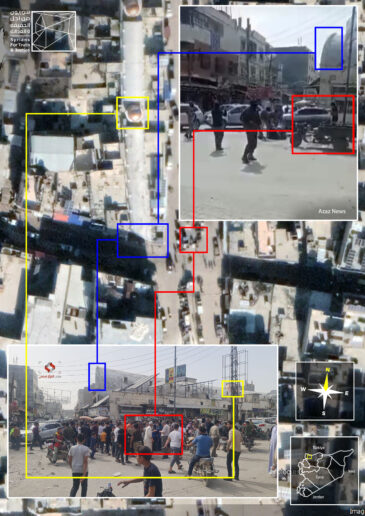 Image 3- STJ designed this image based on open sources and obtained testimonies. It combines a satellite image (the background) with images from open sources to determine the geographical location of the execution. The image shows cars that correspond in number and color to those mentioned in Fayez Abdel Aal’s testimony. Sources: image 1: A’zaz News Network; Image 2- A’zaz Media Office.
Image 3- STJ designed this image based on open sources and obtained testimonies. It combines a satellite image (the background) with images from open sources to determine the geographical location of the execution. The image shows cars that correspond in number and color to those mentioned in Fayez Abdel Aal’s testimony. Sources: image 1: A’zaz News Network; Image 2- A’zaz Media Office.
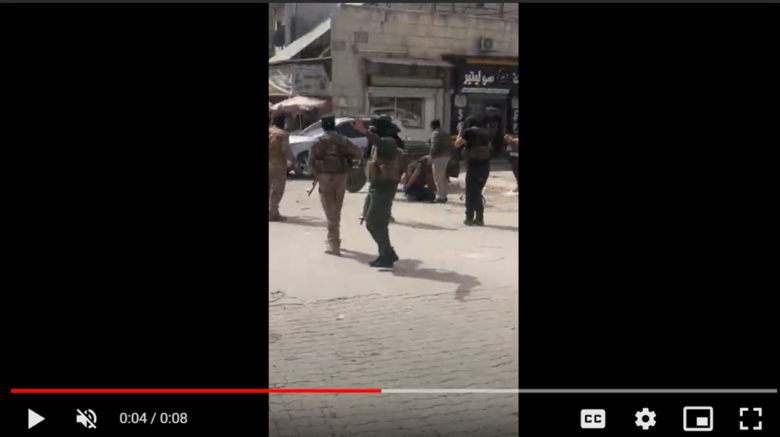 Image 4- Screenshot from a video showing armed and masked men surrounding one of the suspects in the A’zaz bombing before shooting him in the head from behind. Source: Witness Fayez Abdel Aal.
Image 4- Screenshot from a video showing armed and masked men surrounding one of the suspects in the A’zaz bombing before shooting him in the head from behind. Source: Witness Fayez Abdel Aal.
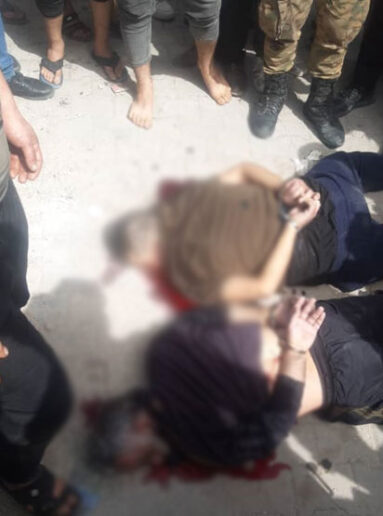 Image 5- Bodies of the two suspects involved in the A’zaz bombing after they were shot in the head from behind. A black band appears around the neck of one of them. Source: Witness Fayez Abdel Aal.
Image 5- Bodies of the two suspects involved in the A’zaz bombing after they were shot in the head from behind. A black band appears around the neck of one of them. Source: Witness Fayez Abdel Aal.
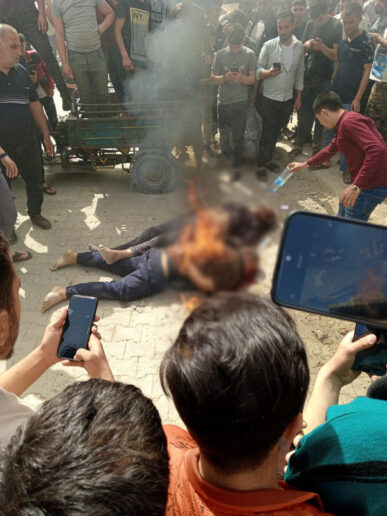 Image 6- Burning the bodies of the two suspects after they were shot in the head from behind by a member of the Levant Front’ security forces. Source: Witness Fayez Abdel Aal.
Image 6- Burning the bodies of the two suspects after they were shot in the head from behind by a member of the Levant Front’ security forces. Source: Witness Fayez Abdel Aal.
-
Perpetrators Go Unpunished
On 25 April, the SIG issued a statement (see Appendix 2) confirming the Levant Front’s narrative, stating that “masked individuals” were responsible for kidnapping two suspects while they were being transported by a Military Police patrol and for their extrajudicial killing. The SIG condemned this as a “criminal act.” It stated that it had instructed the Ministry of Defense and the relevant security and judicial authorities to pursue, arrest the perpetrators, and bring them to justice.
The SIG’s Ministry of Defense, used the term “unknown” to refer to the individuals involved in the killing of the two suspects. This statement was published on 25 April 2024 (see Appendix 3). The Ministry stated, “Our competent authorities have opened an investigation against the individuals who kidnapped the perpetrators of the terrorist attack from the hands of the security and judicial authorities and killed them.” The Ministry emphasized, “The trials and punishments of all criminals should be conducted only through fair and independent courts.”
Mahmoud refuted the Ministry’s claims on opening an investigation into the killing, saying,
“Those who were arrested were two young civilians involved in burning the bodies. They were photographed, obliged to sign a pledge, and then released. This was done to prevent the Military Police from conducting or being involved in any investigations into the case.”
Mahmoud added:
“The Levant Front took this action in response to the will of its leaders, fighters, and some of the notables of in A’zaz to seek retribution from the perpetrators. The best approach to follow here was that of Ahrar al-Sharqiya in killing the child’s rapist and killer in the Peace Spring area.”
In 2022, the Ras al-Ayn/Serê Kaniyê city, controlled by the SNA, experienced a similar incident involving the killing of a suspect accused of child rape. The suspect was being transferred from the Military Police headquarters to the civil police headquarters for judicial presentation when “masked men” killed him. Subsequent investigations revealed that SNA factions, mainly Ahrar al-Sharqiya, were responsible for the killing, which had been authorized at the leadership level in the factions and coordinated with the Military Police. Similarly, no official investigations were initiated to apprehend the perpetrators, and the factions openly declared their support for the killing of the suspect.
-
Extrajudicial Killing
-
Locally
The killing of the suspects, as described in the report, is considered extrajudicial because non-law enforcement individuals carried it out. The Levant Front’s claims about the suspects’ confessions cannot be considered conclusive evidence, especially if the confessions were obtained through torture during their detention, a method allegedly used by the SNA in its controlled areas. Additionally, a confession alone cannot convict the suspects without supporting evidence presented to a specialized judicial body, as Article 176 of the 1950 Syrian Code of Criminal Procedure outlines. Therefore, assuming the confessions are valid, the suspects should have been brought before a specialized judicial body to properly investigate the case and issue a legal ruling according to the procedures stipulated in the Syrian Code of Criminal Procedure, which the SIG and its affiliated bodies claim to adopt with the other pre-2011 Syrian laws.[4]
In the same vein, the Syrian Penal Code No. 148/1949, which the SIG claims to adopt, criminalizes the violation of the sanctity of the dead and the destruction of all or part of the corpse (Articles 463-465). Burning the bodies of murdered persons is considered a destruction of the corpse and one of the greatest violations of the sanctity of the dead.
It is important to note that even if the suspect is brought before the judiciary in that area and the crime is proven against him, those courts do not have the right to issue a death sentence. This is because the judiciary in those areas follows Syrian law, which requires the approval of the pardon committee and the head of state for the execution of a death sentence after the issuance of a final judicial ruling.[5] However, this approval is not available in the area where the crime occurred because it is outside the control of the Syrian government.
-
Internationally
The killing of the two suspects without bringing them before a court is considered a violation of international humanitarian law. This goes against Common Article 3 of the four Geneva Conventions of 1949, which prohibits handing down judgments and carrying out sentences without a prior trial before a legally established court that ensures all necessary legal protections. The right to a fair trial is considered one of the accused’s fundamental rights, as outlined in Article 10 of the Universal Declaration of Human Rights of 1948 and Article 14 of the International Covenant on Civil and Political Rights of 1966.
Since the two suspects, in this case, did not receive the necessary judicial guarantees from the relevant armed groups, their extrajudicial killing constitutes the crime of willful killing under Article 8 of the Rome Statute of the International Criminal Court, which is derived from Article 3 common to the four Geneva Conventions. Therefore, it may amount to a war crime. Thereby, the leaders in those factions must take immediate measures to hold those involved accountable.
During an armed conflict, military commanders of non-state armed groups can be held criminally responsible if they knew or should have known that their subordinates committed war crimes and did not take action to hold them accountable. A commander may be held criminally responsible if they fail to utilize the available judicial system under their control to prosecute war crimes.
According to international humanitarian law, as outlined in the four Geneva Conventions of 1949 and their two Additional Protocols of 1977, it is required that personal dignity be respected, and humiliating or degrading treatment should be avoided, even of dead bodies. Parties involved in a conflict must make efforts to locate and retrieve the bodies of the deceased from the opposing side and take necessary measures to prevent any looting or theft of them. If it is not possible to repatriate the bodies due to the circumstances of war, they must be buried per the deceased’s religious and sectarian customs. Burning of bodies is only permissible for compelling health reasons or in adherence to the religion of the deceased.
Furthermore, according to Article 8 of the Rome Statute of the International Criminal Court, serious violations of the four Geneva Conventions of 1949 are regarded as war crimes. It is undeniable that the desecration of the deceased during military operations constitutes a breach of the aforementioned Geneva Conventions. Therefore, individuals who commit the act of mutilating corpses must be held accountable before a fair and impartial judicial system. Additionally, Rule 113 of the customary international humanitarian law (IHL) emphasizes the obligation of each party in a conflict to take all necessary measures to prevent the plundering and mutilation of the bodies of the deceased.
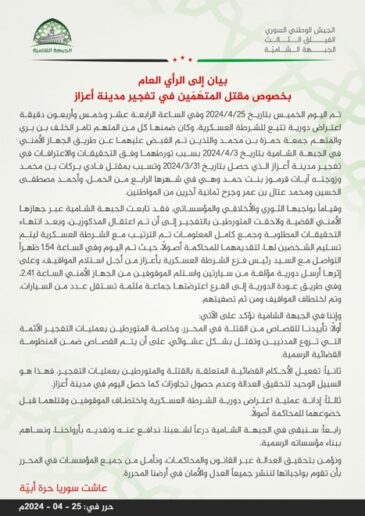 Appendix 1- Statement to public opinion regarding the killing of the accused in the A’zaz bombing, issued by the Levant Front on 25 April 2024.
Appendix 1- Statement to public opinion regarding the killing of the accused in the A’zaz bombing, issued by the Levant Front on 25 April 2024.
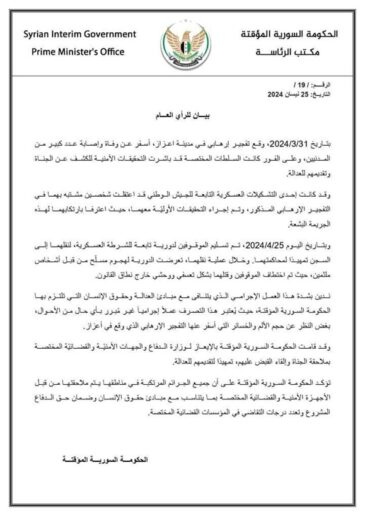
Appendix 2- Statement to public opinion issued by the SIG on 25 April 2024.
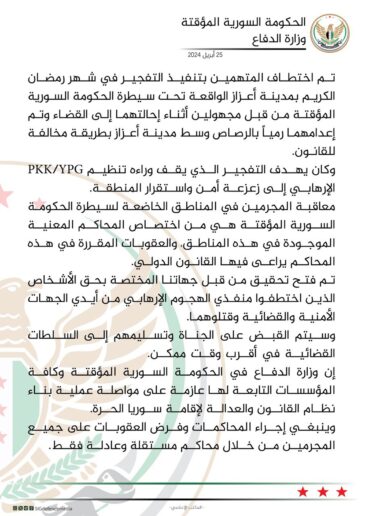
Appendix 3- Statement issued by the Ministry of Defense of the SIG on 25 April 2024.
_______________________________________________________________________________________________________________
[1] The Levant Front/Al-Jabha al-Shamiya was established in 2014 through the merger of several major armed factions in Aleppo, including the Nour al-Din al-Zenki Brigades, the Mujahideen Army, the Islamic Front, the Fastaqim Kama Umirt Union, the Authenticity and Development Front, and the Suqour al-Sham Brigades. Currently, the Front is under the leadership of Azzam al-Gharib (better known as Abu al-Ezz Saraqib), who was previously associated with the faction led by Muhannad al-Khalaf (Abu al-Ezz Saraqib Abu Ahmed Nour).
The Levant Front/Al-Jabha al-Shamiya makes up the largest part of the Third Corps of the SNA. The Front controls the entire city of A’zaz and had previously withdrawn from the city of Afrin after fighting with the HTS.
[2] Pseudonym of a military source interviewed online by an STJ field researcher on 1 May 2024.
[3] Pseudonym of a local source interviewed online by an STJ field researcher on 3 May 2024.
[4] Paragraph 70 of the report of the Independent International Commission of Inquiry on the Syrian Arab Republic, issued on 31 January 2019.
[5] Article 43 of the Syrian Penal Code states: “Any death sentence shall be reviewed by the Special Pardon Committee and the President of the Republic before its enforcement.”

